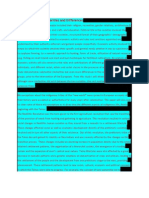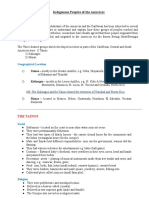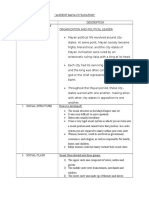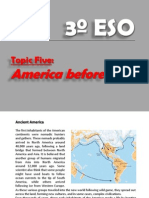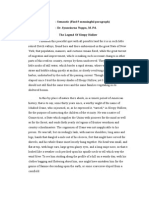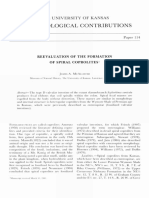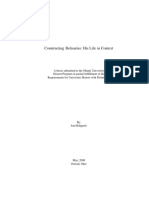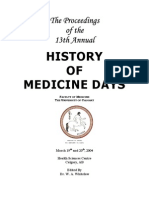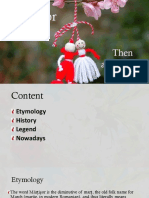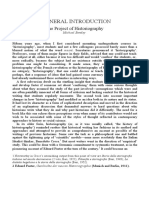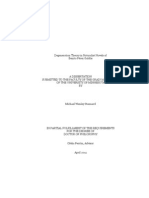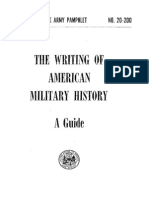HISTORY UNIT 1 NOTES
Second week Notes:
The creation of inland fishing ponds: the Mayans engaged in massive fishing ventures tho most
of their civilization was inland they created ideal canoes that could travel the sea and capture fish
of all varieties. Overtime they blocked inland rivers, creating artificial ponds which housed
numerous varieties of fish for the people in the empire
Capturing and maintenance of forest deers: the Mayans kept some form of animals but not to the
extent of the Incas. Forest deers were plentiful in Central America and as the Mayans cleared
more and more land these animals were captured. They were fed and raised by their owners until
they were ready to be slaughtered. This provided a ready source of protein for their diet.
Terracing: the development of terraces in hilly areas to prevent soil erosion and to make the land
fertile
Why the Mayans were able to develop into a more advanced society
The Mayans were a communal people and the fact that they had the determination to work
together was one of the main reasons for their development into an advanced society. The
Mayans worked for a common cause which was the overall development of their society.
The increase in their population resulted in a constant flow of workers that benefited the society.
The common people under supervision enjoyed effective division of labour which meant more
progressive activities.
In the Mayan society like in all other indigenous societies religion played an essential role.
Religion was a mechanism used to instill obedience in the people. For example, they will work
hard to please their gods as they were highly polytheistic in nature.
The Mayans were highly militaristic in nature and so war was extremely important. War was
employed at all times to capture other indigenous groups or to displace others in order to extend
their boarders. The people who were conquered were used as slaves and were forced to become
apart of the work force
Another key factor to the success of their civilization was their availability of land and it’s
common resources. They were not restricted by mountains, thus they were able to use the natural
terrain and expand their empire
The existence of a strong political system was crucial to their accomplishment as an advanced
society. The population respected the orders of their leaders, nobles and chiefs, as a result they
�were equipped to follow plans in advancing their society. Specific sanctions were enforced in the
city states under each leader.
They were also great artistic builders, this is manifested in the structures they have left behind
(pyramids)
Evidence of established social and political systems in the Mayan society
Social
The Mayans had an organized society based on prestige and status. Like European states in the
1400s people were treated according to their status. In their advanced organized society there
were agricultural workers, artisans, soldiers, priests and nobles. The nobles and priests held high
positions in the Mayan society. Each group had their own social treatment, standard of living and
privileges.
They had advanced agricultural systems; they created large farm lands using irrigation, artificial
fishing ponds, slash and burn, draining of swampy lands, terracing and reservoirs. Many of these
practices are still being used today and this is important to note these advanced systems
Skilled craftsmen were able to design and maintain sculptures, monuments, buildings made of
stone and temples. Paintings were done in the 3 dimensions. They created bridges roads and
markets which helped with communication and economic development. Constantly expanding
the boarders of their empire similar to the imperialistic nature of the Europeans. In Europe the
amount of land the country had determined their strength and power. Likewise the Mayans held a
campaign of war against other indigenous groups. Their lands would be incorporated into Mayan
lands when the war was lost and the people they caught would be used as slaves. Effective law
enforcement showed that the Mayans were an advanced group socially. They had laws which
governed their city states so as to protect the commoners who formed the basis of their society
and work forces
Political
The organization of their city states suggested the advancement of their political systems. The
Mayan society was divided into numerous city states, each city state had a great degree of
political independence yet they were still integrated. They had a policy of inheriting leaders.
Kings and nobles could only be given positions based on their kinship to the previous leaders.
Each leader was assigned a council of men which acted as advisors and lesser leaders. This is
common to present day cabinets were the prime minister may have members of parliament
concerning different portfolios. There was constant recruiting of warriors to protect their empire.
These men would be recruited as of early as puberty and they were trained in combat by war
chiefs and leaders called batabobs. This was to ensure military supremacy and national security.
These groups of men would form large military forces to expand their empire through wars.
�These use of political and military power to enforce laws and rules suggested how the Mayan
society functioned
Practice Question
Select one of the advanced indigenous American groups and discuss the factors that enabled the
selected group to develop as an advanced society before 1492 (pre Columbus era)
Third week:
Contact before 1492
Christopher Columbus came to the Americas in 1492, from this point forward history has been
that the Europeans were the first group to come to the Americas and to have influenced the
cultural, economic, social and political development of the Americas. History had been written
from a Eurocentric point of view, however studies have shown that:
● The Africans may have come to the Americas over 300 years before Columbus arrived
● The Europeans (Norse or Vikings) came to the Americas (Canada/North America)
from about the 10th century
From as early as the 1920s, Africanist historians, Leo Weiner, published “Africa and the
discovery of the Americas”, arguing that the west Africans had arrived in the Americas long
before Columbus. His beliefs were appreciated by a few but ignored by many. Ivan Van Sertima,
“They Came before Columbus” 1976, wrote extensively on modern discoveries to support this
thesis and paved the way for further research in the area. Ivan Van Sertima’s thesis argued that
Africans came to the Americas in the pre Colombian period and were able to influence the
socioeconomic, cultural and political development of indigenous societies particularly those of
the Olmec civilization, who were the indigenous groups in Mexico and Central America.
African proverb
“Until the lions have their own historians, tales of the hunt shall always glorify the hunter”
How and why did the Africans come to the Americas
● It is believed that the first Africans that came to the Americas were traders who wanted
to explore the Atlantic Ocean and trade with the indigenous people
● It is estimated that they had arrived some 300 years before Columbus arrived in the
Americas. It is argued that the Africans that had came to the Americas were respected
by the indigenous people and were able to integrate into indigenous society. The effects
of this is that they were able to influence the cultural, social, economic and political
development of the Americas. According to Van Sertima’s thesis it is possible that the
� first group of Africans who arrived in the Americas were Egyptians (751 BCE) (BCE-
before common era), and the Mandingo people of the Mali empire (1310 and 1311)
African visits to the Americas
Oral history of the Mali people: King Abu Bakr II
Van Sertima argued that the first visit of the Africans to the Americas must have been seriously
mistaken. By this they arrived by mistake probably from being trapped in the trade winds in the
Atlantic Ocean. Van Sertima wrote in 1972 “Then there is oral history of the 2 peoples. The
Griots, traditionally historians and masters of orature (oral literature) in Mali, have stories about
their king Abu Bakr, the second grandson of Sundiata, the founder of the Mali empire who set
out on a great expedition with large boats and none of the boats returned to Mali”. Apparently
the ships had been pulled away by the trade winds and currents and because of their nature they
could not fight the currents and winds
The story of king Abu Bakr (Abu Bakr II) is that some time in the early 1300s he wanted to
explore the Atlantic Ocean due to the knowledge he received from the Arabs. He sent an
expedition with several ships laden with goods, people, animals, plants and luxury items to sail
across the Atlantic. Only one ship returned advising him that the rest of the ships were pulled
away by winds and currents of the Atlantic ocean. He was excited about the prospect of finding
land and so he again loaded several ships and decided to personally lead the voyage. He left his
brother, Man Samusa (Musa I), in charge. Abu did not return.
Trade winds and currents (oceanography:
The trade winds and currents in the Atlantic Ocean could explain why the Africans were able to
reach the Americas. These trade winds and currents are continuous throughout the years and is
difficult to navigate them
Columbus’ writing:
Van Sertima and other Africanist writers/historians relied heavily on Columbus’ writings. There
is evidence that Columbus was convinced that he could sail west to reach the east because of
what he learnt of the Atlantic Ocean in West Africa. Africanist historians argue that Columbus
learned about the trade winds and currents in the Atlantic Ocean and that several voyages were
made to the Americas by the Africans. It was this knowledge that gave him the confidence to
travel across the ocean. Columbus was the first European to speak about the presence of black
people (Africans) in the Americas. When Columbus landed in Hispaniola the Taino people told
him that the spears they had were given to them by black men. In his diary Columbus wrote
“their had come to Hispaniola people who had the tops of their spears made of metal which they
called quanine, of which he had sent samples to the sovereigns (king and queen of Spain) to have
them assayed, when it was found that 32 parts, 18 were gold, 6 silver and 8 copper. These
�samples were sent to Spain on a male boat and were found to be identical to what was being
forged or made in Guinea in Africa
Wednesdays Notes:
Columbus son: Ferdinand Columbus stated in his diary that his father told him that he saw
several black persons in the Americas when he arrived.
Archaelogical Evidence- another name is hard Evidence:
Many historians did not accept the oral history evidence and the writings of Columbus claiming
that they were not strong evidence, the most significant evidence of African presence in the
Americas has to be archaelogical evidence. These are tangible things you can see including the
pyramids, the stone heads, skeletons, the loom and others.
Pyramids: Historians believes the step pyramids found in the Americas can be traced to ancient
Babylon and Egypt.
Pyramid building was a specialized form of construction in Egypt they progressed from the step
pyramids ot "Djaser", to the finished products at "Giza". At "La Venta" which was the location of
the first pyramids in the Americas. The pyramid found was a fully finished one. There was no
sign of progressive learning which meant that they had to learn from someone. Africanist
Historians say there is no evidence of progressive learning, therefore they must have learnt from
others how to build these huge pyramids in the Americas.
African Skeletons: in February 1975 two negroid male skeletons were found by a team from the
" Smithsonian Institute" found two negroid male skeletons. These skeletons were found in the
US Virgin Islands in a grave that was used & abandoned long before Columbus arrived. The soil
was dated to be about 1250 AD. The teeth showed "dental mutilation" characteristic of early
African Cultures. This discovery in 1975 would indicate that Africans were in the Americas
before Columbus.
Rossum (1996)- in Rossam writing he argued that there is no conclusive evidence that the
skeletons found were of Africans because the studies done had compared the skeletons to
modern old world people. Some historians argued that the indigenous people came to the region
from Asia. There is no conclusive evidence that black people (africans) were not among them.
�Stone heads: It was found that many indigenous societies in south and central america had some
art form indicating that of African teachings. In the Mayan communities such as "Tres Zapotes"
and "La Venta" in Mexicon for example.
Colossial stone heads were found that according to "Dr.Michael Sterling". "Were bold and
amazingly negroid in nature" all the stone heads had features that indicating an african features
such as fullness of the lips, the broad flashy nose, the lines of the cheeks and jaws & ethiopan
braid style.
The heads did not resemble the indigenous people, africanist historians believe it was possible
that these people who came across the atlantic were so respected that the indigenous people
would have made monuments to worship them.
The features of the stone heads- not all historians are convinced that the stone heads are actually
negroid in nature. "Coe (1983)" felt that the artist carving the skulptures did not have appropriate
tools to make them smaller. "Bernal (1965) argued that the skulptures were really of a
human/jaguar combination.
Loom- this was a machine used for making cloth. Loom of horizontal types appeared in Peru. It
was found to be identical to a horizontal loom depicted in an egyptian tool.
When the 4 vertical looms appeared in Peru, they were identical to those found in a toom at
"Tebes"- the sacred capital of the Black King. Both the new world & the old world looms had the
same two working parts.
Botanical evidence- from civilizations such as the Mali Empire,Songhai and Egypt came
principal American foods. Cotton seeds, banana plant, bottle gourd, jack beans and the west
african yam all had african origin and they had suddey appeared in the anericas without
explanation. Arab merchants brought cotton cloth to Europe about 800 AD when Columbus
"discovered" the americas in 1492 he found cotton growing in the islands of the bahamas. By
1500 cotton was known generally throughout the world. Critics argue that most of the plants
found in the Americas that were of west african origin could have come to the region by way of
�bird droppings or ocean currents. There is little evidence that africans came to the region &
brought these crops.
The Mayan Calendar & its similarity. Another indication of african presence in the Americas
before Columbus is the Mayan Calendar. The calendar the mayan people used was based on the
moon & the sun. It was quite accurate & very similar to the Egyptian Calendar.
"Professor Weiner" believed that Mayan Mathematics corresponded with the number system of
the Bambaras of Guinea. Both people organized their year into 366 days with 12 months of 30
days & each added 5 days to every year. Both used these excess 5 days for worship & relaxation.
Ethiopian calendar is a little behind us who use the roman empire calendar.
Linguistic evidence- (language evidence) close examination revealed the meanings assigned to
the different lingusitic evidence of the Africans and South Americans. It is evident that the west
African languages and South American languages are similar. These similarities can be traced to
common root words. These differences are too close to occur so frequently to be coincidence.
The Mayan word for market place is Tan Quazro which was closely linked to the west african
"tangoz mao" meaning trader.
Writing skills- another indication was the writing system used in the Americas called mic mac
hieroglyphs. When comparing this style of writing to the simplier cursive form of egyptian
hieroglyphics called hieratic, over half were found to be similar. Closer examination revealed
that the meanings assigned to these signs matched.















